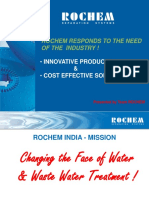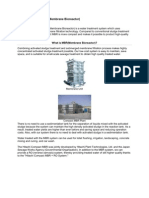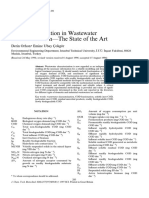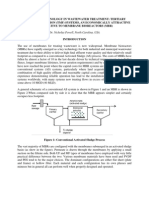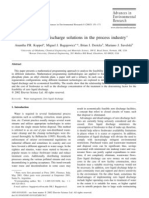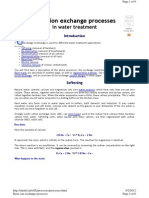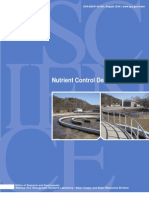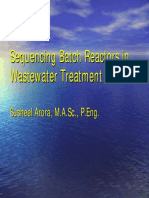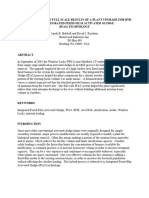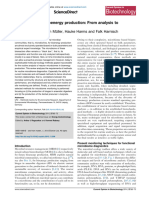Applying Internal Circulation Anaerobic Reactor Fo
Applying Internal Circulation Anaerobic Reactor Fo
Uploaded by
Alvaro HueteCopyright:
Available Formats
Applying Internal Circulation Anaerobic Reactor Fo
Applying Internal Circulation Anaerobic Reactor Fo
Uploaded by
Alvaro HueteOriginal Description:
Original Title
Copyright
Available Formats
Share this document
Did you find this document useful?
Is this content inappropriate?
Copyright:
Available Formats
Applying Internal Circulation Anaerobic Reactor Fo
Applying Internal Circulation Anaerobic Reactor Fo
Uploaded by
Alvaro HueteCopyright:
Available Formats
See discussions, stats, and author profiles for this publication at: https://www.researchgate.
net/publication/336947073
APPLYING INTERNAL CIRCULATION ANAEROBIC REACTOR FOR
WASTEWATER TREATMENT: A CASE STUDY IN SAIGON PAPER MILL
WASTEWATER TREATMENT PLANT
Article · January 2019
DOI: 10.21307/ACEE-2019-045
CITATIONS READS
0 187
2 authors, including:
Ha Manh Bui
Saigon University
50 PUBLICATIONS 72 CITATIONS
SEE PROFILE
Some of the authors of this publication are also working on these related projects:
Eliminating pollutants using Electroc techiques View project
Application of quantitative real-time PCR (Q-PCR) and molecular biology to study cyanotoxins and explore genetic diversity of cyanobacterial population in the Tri An
Reservoir View project
All content following this page was uploaded by Ha Manh Bui on 03 November 2019.
The user has requested enhancement of the downloaded file.
A R C H I T E C T U R E C I V I L E N G I N E E R I N G E N V I R O N M E N T
T h e S i l e s i a n U n i v e r s i t y o f Te c h n o l o g y N o. 3 / 2 0 1 9
doi: 10.21307/ACEE-2019-045
APPLYING INTERNAL CIRCULATION ANAEROBIC REACTOR
FOR WASTEWATER TREATMENT: A CASE STUDY IN SAIGON
PAPER MILL WASTEWATER TREATMENT PLANT
Nhat-Ha TRAN a and Manh-Ha BUI b*
a BSc; Department of Environmental Sciences, Saigon University, 273 An Duong Vuong Street, District 5,
Ho Chi Minh City 700000, Vietnam
b PhD; Department of Environmental Sciences, Saigon University, 273 An Duong Vuong Street, District 5,
Ho Chi Minh City 700000, Vietnam
*E-mail address: manhhakg@sgu.edu.vn
Received: 24.06.2019; Revised: 8.07.2019; Accepted: 8.07.2019
Abstract
Internal Circulation reactor (IC reactor) is an anaerobic digestive system with the capability to treat high-load Chemical
Oxygen Demand (COD) of industrial wastewater (e.g. brewery, potato starch, pulp and paper). IC reactor advantages
include of the following: only small areas required, shock load resistance, produces more biogas and uses less energy com-
pared to the Upflow Anaerobic Sludge Blanket (UASB) reactor. BIOPAQ@ICX is an upgrade to BIOPAQ@IC that has high-
er efficiency, lower volume, able to build from the current anaerobic reactor, and its trial has produced positive results in
many different countries and with various types of wastewater. A case study of the wastewater treatment plant at Saigon
Paper’s mills shows that the IC reactor COD removal rate is over 80% when the COD is not over 2300 mg/L; Volumetric
Load Rate (VLR) is 6–14 kgCOD/m3.day and the removal rate is higher with a higher load and could reach 80% at
14 kgCOD/m3.day; granular sludges settle very well, and the three-phase separator is efficient of preventing sludge from
washing out; pH, Total Suspended Solids (TSS), alkalinity, Volatile Fatty Acids (VFA), N-NH4+, P-PO43-, Ca2+, SO42- were
also analysed and indicated that the IC reactor is operating well.
K e y w o r d s : Internal Circulation reactor (IC reactor); Paper mill wastewater; Granular sludge; Organic compounds.
1. INTRODUCTION anaerobic processprevail due to its advantages over
aerobic:it requires no oxygen has a high load Chemical
Industrial wastewater containing high organic com- Oxygen Demand (COD), and minimizes sludge pro-
pounds and high flow rate has always been a problem duction Many types of industrial wastewater treatment
in developing and developed countries. To addressed systems could not operate well with the absence of
the issue, many possible treatments have been devel- anaerobic treatment. Currently, the most popular
oped through years of researches, some can be men- anaerobic treatment is the Up-flow Anaerobic Sludge
tion such as coagulation, [1] absorbance [2] and Blanket (UASB), which has been successfully applied
advanced oxidation process; [3; 4] however, biological in many types of wastewater [7]. However, industrial
treatments are favoured as they are environmental wastewater resulting from the manufacturing of pulp
friendly, high BOD, COD removal rate, able to treat and paper, alcohol, citric acid and sweet potato has a
N and P. Two of the most popular processes in biolog- very high COD, and the UASB is incapable of treating
ical treatments are aerobic and anaerobic, they use these types of wastewater due to its high Organic
microorganisms as a tool to treat organic industrial Loading Rate (OLR). As the average UASB OLR is
wastewater [5; 6]. Although both processes are neces- only about 1–2 kgCOD/m3.d, [7] it is necessary to
saries in most complete wastewater treating system,
3/2019 ARCHITECTURE CIVIL ENGINEERING ENVIRONMENT 145
N. Tran and M. Bui
apply a different method of biological treatment.
Internal Circulation Reactor (IC reactor) is an anaer-
obic treatment with a high removal rate of industrial
wastewater that has a very high COD (up to
35000 mg/l) and organic load [8–10]. Despite its
potential, the IC reactor has not been recognised by
many investors, and there are only a few studies on it.
Therefore, this study will focus on the assessment of
the IC reactor applied to wastewater treatment by
introducing a case study of one of Saigon Paper’s
mills to investigate its performance.
Development of IC reactor
In the mid 1990s, the second generation of anaerobic Figure 1.
treatment (with the first being UASB) was intro- Internal circulation reactor[12]
duced with the name BIOPAQ@IC. The
BIOPAQ@IC reactor’s height is 12–30 m, whereas
well with the influent; external circulation is optional
the UASB is 5–7 m. Many investors then took notice
as internal circulation occurs, saving energy needed
of the reactor due to its size and thus BIOPAQ@IC
for external circulation; internal circulation also
has gradually begun replacing the UASB. Currently,
helps dilute the influent, so the IC reactor has a high-
there are around 280 wastewater treatment systems
er shock loading [9].
designed and built by BIOPAQ, with 200 of these
being BIOPAQ@IC [9; 11].
IC reactor inhibitors
IC reactor processes As an anaerobic system, many factors should be con-
sidered while operating an IC reactor. The first factor
IC wastewater treatment is an anaerobic process;
is temperature as the effect of temperature on anaer-
therefore, the IC reactor is capable of treating
obic microorganisms is particularly significant as
biodegradable organic compounds, and this is usual-
methanogens produces more methane in high tem-
ly done before the aerobic process. The IC process is
peratures, indicating a better COD removal process.
as follows: An IC reactor is composed of three com-
The second and most important inhibition factor in
ponents; wastewater is pumped into the first compo-
anaerobic digestion is pH depending on how sensitive
nent of the reactor which has a bed of granular
methanogens are to pH changes. The optimum pH
sludge. Due to the production of biogas, the mixture
should be 6.8–7.2, and alkalinity is the factor that
of wastewater and sludge goes up to the riser and
maintains the pH of the reactor, and so it is also very
flows to the third component where gas and liquid
important to have sufficient alkalinity concentration.
are separated. After the separation, the mixture of
Toxic substances, such as oxygen, ammonia, cations
wastewater and sludge is directed through a downer
and heavy metals are the third factor that must be
and back to the bottom of the first part; the higher
considered when applying an anaerobic digestion sys-
the COD load, the more biogas will be produced,
tem [13] as it could potentially damage bacteria need-
leading to more circulation. The second component
ed for the anaerobic digestion process. The last
of the IC reactor is responsible for treating the waste-
inhibitor is Volatile Fatty Acids (VFA), a study by
water with a lower organic load from the first com-
Zhu, et al. (2018) [14] has shown VFA effects on
ponent, and the treated wastewater then flows out for
anaerobic digestion whereby the higher the level of
the next treating process.[8]
VFA, the lower the COD removal rate.
Due to its unique mechanics, the IC reactor has many
advantages over the UASB: investment cost is lower IC reactor wastewater treatment plants
as the IC reactor volume is smaller but treats the
same type of wastewater; it is taller, therefore saving Table 1 shows that the IC reactor is able to treat varieties
the ground space usually required; OLR is higher but of wastewater with high COD loads. The removal rate
with lower hydraulic retention because internal circu- varies depending on which type of wastewater is being
lation is occurring inside the reactor and mixes very treated, with most of it being over 75% while many
146 ARCHITECTURE CIVIL ENGINEERING ENVIRONMENT 3/2019
APPLYING INTERNAL CIRCULATION ANAEROBIC REACTOR FOR WASTEWATER TREATMENT: A CASE STUDY IN SAIGON PAPER MILL...
e
E N V I R O N M E N T
Figure 2.
VFA and COD removal rate correlation[14]
Table 1.
IC reactor treatment plants[8; 14]
COD load Removal
Wastewater Company COD(mg/l)
(kgCOD/m3.d) rate (%)
Brewery Harbin brewing (Shenyang) Co.,Ltd 2000–2800 - 80
Sweet potato
in Zhengzhou 10865 21.9 84
starch
Fujian Nanping Paper - 12–15 65
Pulp and
paper YueYang Paper Co.,Ltd and Gaungxi Bossco Environment
- 20–26 > 75
protection Technology Co.,Ltd
Table 2.
BIOPAQ@ICX performance of Allard Emballages, France and Hamburger, Hungary compared to UASB average performance[15]
Treatment specification of BIOPAQ@ICX UASB average performance
Country France Hungary Country UK
COD load (kgCOD/m3.day) 6000–7000 7000 COD load (kgCOD/m3.day) 0.8–5.68
Flow rate (m3/h) 70–80 400–500 Flow rate (m3/h) 46–326
Biogas produce (m3/day) 2400–3000 15000 – 25000 Biogas produce (Nm3/day) 439–5992
Biogas quality (% CH4) 70 - Biogas quality (% CH4) 43.7–69.1
Removal rate (%) 80–90 74–90 Removal rate (%) 70–80
effects could have lowered its efficiency, such as systems new anaerobic digestive system called
operation, adaptation of the reactor microorganisms to @
BIOPAQ ICX, an upgraded reactor from
the following influent and increasing toxicity. BIOPAQ@IC. Compared with BIOPAQ@IC,
BIOPAQ@ICX has a different construct: instead of
having a three-phase separator, BIOPAQ@ICX sepa-
IC reactor upgrade
rates gas on the top level while biomass separation
To meet the requirements of treating different types occurs in the bottom of the reactor, which enhances
of industrial wastewater, PAQUES has introduced a efficiency and prevents sludge wash out. Spare vol-
3/2019 ARCHITECTURE CIVIL ENGINEERING ENVIRONMENT 147
N. Tran and M. Bui
Table 3. tor to treat wastewater produced in the process of
Saigon Paper mill IC reactor operating design making paper products, but due to its low perfor-
IC VLR Sludge mance, the mill decided to change the technology to
Diameter Height HRT
volume v (m/h) (kgCOD/ volume
(m) (m) (h) meet the requirements of the wastewater effluent.
(m3) m3.d) (m3)
1395 9.5 20 4 45 m/h 6–14 650–750 Two IC reactors were invested in to treat wastewater,
but only one is currently being used with a flow rated
approximately measuring 8400 m3/day and the
Volumetric loading rate (VLR) is 6–14 kg/m3.day.
The IC reactor is 20 m high and 9.5 m in diameter,
making a total volume of 1395 m3. This study will
focus on the performance of the IC reactor through
its removal rate, granular sludge settleability and
other parameters.
2. MATERIAL AND METHODS
Figure 3.
Saigon Paper mill IC reactor
Influent and effluent samples were taken to measure
IC reactor parameters by applying Standard Methods
for the Examination of Water and Wastewater to
ume in the reactor will be used at its full potential, COD (5220 C.4), TSS (2540 D.3), Alkalinity (2320
therefore decreasing the volume of BIOPAQ@ICX B.5), N-NH4+ (4500-NO3 C.4)., P-PO43-(4500-P C.4),
[11]. In 2013 and 2014, BIOPAQ@ICX was tested in Ca2+ (2340 C.3), SO42-(4500-SO42- D.4). pH was
the Netherlands and after its success, the system was
measured on site by means of HACH HQ 11d pH
applied to a brewery, a sugar processing plant and
meter. VFA measurements were conducted following
two paper plants in France and Hungary.
Buchauer (1998) [16] titration method. A 50 mL sam-
ple was taken and filtered. 0.1 N HCl and 0.1 N
Case study NaOH were used as titrants, and the VFA concentra-
Saigon Paper mill in My Xuan A Industrial Park, Tan tion was calculated with the use of the following
Thanh District, Ba Ria-Vung Tau had a UASB reac- equation:
Figure 4.
Effect of COD concentration on COD removal
148 ARCHITECTURE CIVIL ENGINEERING ENVIRONMENT 3/2019
APPLYING INTERNAL CIRCULATION ANAEROBIC REACTOR FOR WASTEWATER TREATMENT: A CASE STUDY IN SAIGON PAPER MILL...
e
( volH2SO4pH5 to 5 x 0.1 x 131340
) 3. RESULTS AND DISCUSSUON
E N V I R O N M E N T
VFA(mgL) = –
sample volume
Figure 4 shows that the COD removal percentage
–
( 0.0616 x ( volH2SO4pH4.3 x N H2SO4 x 50000
sample volume )) – 10.9
changes depending on the COD concentration.
While for the COD concentration ranged from
1500–2500 mg/l, COD removal efficiency was above
80% and stable with the COD load up to 2300 mg/l.
When introduced with COD concentration over 2300
Table 4. mg/l, the removal rate drops to 72% as a result of
Saigon Paper mill IC reactor influent and effluent tests
overload and therefore we can determine the maxi-
result
mum COD load of the reactor.
Value *QCVN
Parameters Unit The VLR of the IC reactor at the Saigon Paper mill
12:2015/BTNMT
Influent Effluent is 6–14 kg/m3.d, and as Figure 5 shows, the higher the
pH - 5.9–6.5 6.9–7.1 5.5–9 VLR rate the higher the COD removal efficiency.
This has been proven by a study conducted by Zhang,
TSS mg/l 250–400 200–450 100
et al. (2015) [8]. But a paper mill’s VLR could reach
COD mg/l 1500–2500 300–600 150
20–25 kgCOD/m3.d as in the case of Guangxi
Alkalinity mg/l 250–400 851–1000 - Nanning Sugar Industry Co., Ltd. [8] Unfortunately,
VFA mg/l 420–630 85–110 - Saigon Paper’s IC reactor has never shown a VLR
N-NH4 mg/l 20–30 20–30 - higher than 14 kg/m3.d, and only one reactor is cur-
P-PO4 mg/l 4–6 7–9 - rently running so it is not possible to see its maximum
VLR load.
Ca2+ mg/l 300–350 - -
SO42- mg/l 50–100 1–5 - The IC reactor at the Saigon Paper mill’s wastewater
plant is using granular sludge with a volume of
*Vietnamese national technical regulations on pulp and
paper industry wastewater
650–750 m3, which is 53% of the total volume of the
reactor. Using the Imhoff test, results show the granu-
lar settleability works well; sludge was taken from five
points (P1, P2, P3, P4, P5) high at 1.6 m, 5.4 m, 9.2 m,
14 m, 17 m, respectively. The test results are as follows:
Figure 5.
Saigon Paper mill IC reactor Imhoff test results
3/2019 ARCHITECTURE CIVIL ENGINEERING ENVIRONMENT 149
N. Tran and M. Bui
Table 5. 4. CONCLUSION
Saigon Paper mill IC reactor Imhoff test results
P1 (mL/L) P2 (mL/L) P3 (mL/L) P4(mL/L) P5(mL/L) Treating industrial wastewater without causing sec-
830 800 750 0.8 0.2 ondary pollution and recycling clean energy with high
900 770 840 1.2 0.2
efficiency is in demand, and anaerobic treatment can
900 850 810 0.5 0.5
930 850 880 0.2 0.1
meet these expectations. The IC reactor is capable of
900 870 890 0.3 0.4 treating industrial wastewater with high COD load
950 920 950 0.2 0.5 and can adapt to many types of wastewater to
increase its efficiency over time while only small
P1, P2 and P3 has a high concentration of sludge, ground areas are required and there is a lower reten-
which implies how well the sludge settles; P4 and P5 tion time compared with the current UASB reactor;
almost has no sludge available which is mostly due to therefore, it needed more attention from researchers
the three-phase separator, which helps to prevent the and investors by its superior advantages. The upgrad-
sludge from washing out of the reactor. ed BIOPAQ@ICX from BIOPAQ@IC has also shown
positive results from its trial with many types of
Influent and effluent parameter differences could be wastewater, especially paper industry wastewater.
explained: pH maintaining at 7.0 due to the presence Although it is still a new design, its potential will con-
of carbonate or bicarbonate as the IC reactor is a tinue to be researched in the future. A study of the
buffer system [13]. Higher TSS from the effluent Saigon Paper mill’s IC reactor has also been evaluat-
indicated high turbulence inside the IC reactor due ed in this paper, which has shown the removal rate is
to high water velocity influent and water mixing from stable at the COD concentration of 1500–2300 mg/l
the circulation. The three-phrase separators are and is considered as an inhibitor above 2300 mg/l.
designed to hold the granular sludge and so smaller VLR has also affected the removal rate, showing that
sludge could still be washed out along with the efflu- the higher the VLR, the higher the removal rate.
ent. The increase in alkalinity is due to the addition Granular sludge used in the reactor accounted for
CaCO3 to ensure the stable pH of the system and the 53% of its volume and has a good settleability, and by
production of HCO3- by methanogens. During the testing the effluent parameters, the IC reactor is con-
anaerobic processes, VFA levels will certainly drop as cluded to be well operated and fully capable of treat-
these are the material needed to produce biogas by ing pulp and paper wastewater.
methanogens. Microorganisms need to consume N
and P as nutrients to exist, so NH4- and PO4- were
added to feed the microorganisms. The residue of
NH4+ and PO43- remains in the effluent to ensure the REFERENCES
stable conversion processes of the system. Lower [1] Ha, M. B., Yuan, P. S., & Huong, D. T. G. (2016). The
SO42- concentration could be explained by sulphate- use of artificial neural network for modelling coagu-
reducing bacteria using sulphate as a terminal elec- lation of reactive dyeing wastewater using Cassia
tron acceptor for organic matter degradation and Fistula gum. Journal of Environmental Science and
emitting H2S in normal pH conditions [17]. Management, 19(2), 1–10.
[2] Radaideh, J. A., Al Abdulgader, H., & Barjenbruch,
According to QCVN 12:2015/BTNMT, pH value is M. (2017). Evaluation of Absorption Process for
acceptable, but both TSS and COD in the effluent Heavy Metals Removal Found in Pharmaceutical
are not allowed to be introduced into the industrial Wastewater. Journal of Medical Toxicology and
wastewater sewage collector. However, the mill still Clinical Forensic Medicine, 3(02), 1–12.
has an aerobic process and physico-chemical process [3] Ha, M. B. (2018). Decolorization of Suncion Red P-
to continue the treatment. Overall, the removal rate 2B Solution by Gamma Co-60 Irradiation in the
of COD consistently over 80% is proof that the IC Presence of Hydrogen Peroxide. Journal of Advanced
reactor is indeed an important process of the system, Oxidation Technologies, 21(1), 118–126.
and by testing the effluent parameters it can be con- [4] Ha, M. B. (2018). Decolorization of Suncion Red P-
cluded that the reactor is well operated. 2B Solution by Gamma Co-60 Irradiation in the
Presence of Hydrogen Peroxide. Journal of Advanced
Oxidation Technologies, 21(1), 118–126.
[5] Nguyen, P. T. T., Van Nguyen, P., Truong, H. T. B., &
Bui, H. M. (2016). The Formation and Stabilization
of Aerobic Granular Sludge in a Sequencing Batch
150 ARCHITECTURE CIVIL ENGINEERING ENVIRONMENT 3/2019
APPLYING INTERNAL CIRCULATION ANAEROBIC REACTOR FOR WASTEWATER TREATMENT: A CASE STUDY IN SAIGON PAPER MILL...
e
Airlift Reactor for Treating Tapioca-Processing
E N V I R O N M E N T
Wastewater. Polish Journal of Environmental Studies,
25(5).
[6] Truong, H. T. B., Nguyen, T., Thi, P., & Bui, H. M.
(2018). Integration of aerobic granular sludge and
membrane filtration for tapioca processing waste-
water treatment: fouling mechanism and granular sta-
bility. Journal of Water Supply: Research and
Technology-Aqua, 67(8), 846–857.
[7] Daud, M. K., Rizvi, H., Akram, M. F., Ali, S., Rizwan,
M., Nafees, M., & Jin, Z. S. (2018). Review of upflow
anaerobic sludge blanket reactor technology: effect of
different parameters and developments for domestic
wastewater treatment. Journal of Chemistry, 2018.
[8] Zhang, G. Y., Deng, C. B., Zhang, J., & Zhu, H. X.
(2013). Applications about the internal circulation
anaerobic reactor in wastewater treatment industry.
Advanced Materials Research, 694, 3264–3268.
[9] Zhang, A., Shen, J., & Ni, Y. (2015). Anaerobic diges-
tion for use in the pulp and paper industry and other
sectors: an introductory mini-review. BioResources,
10(4), 8750–8769.
[10] Jahren, S. J., & Rintala, J. A. (1997). The closure of
water circuits by internal thermophilic (55 and 70°C)
anaerobic treatment in the thermomechanical pulp-
ing process. Water Science and Technology, 35(2),
49–56.
[11] Valijanian, E., Tabatabaei, M., Aghbashlo, M.,
Sulaiman, A., & Chisti, Y. (2018). Biogas Production
Systems. Springer.
[12] Reith, J. H., Wijffels, R. H., & Barten, H. (2003). Bio-
methane and bio-hydrogen: status and perspectives of
biological methane and hydrogen production. Dutch
Biological Hydrogen Foundation.
[13] Hou, L., Ji, D., & Zang, L. (2018). Inhibition of
Anaerobic Biological Treatment: A Review. IOP
Conference Series: Earth and Environmental Science,
112(112), 1–7.
[14] Zhu, L. F., Guo, Y. P., Huang, D. D., Tian, Y. e., &
Liu, L. L. (2018). Operating Characteristic of IC
Reactor Treating Wastewater of Sweet Potato Starch.
Advanced Materials Research, 374, 905–908.
[15] Cairns, R., & Mead, P. (2017). Performance of a
UASB effluent treatment plant treating malt ingredi-
ent manufacturing wastewater. Environmental
Management and Sustainable Development, 6(2),
198–210.
[16] Buchauer, K. (1998). A comparison of two simple
titration procedures to determine volatile fatty acids
in influents to waste-water and sludge treatment
processes. Water SA Pretoria, 24, 49–56.
[17] Long, Y., Fang, Y., Shen, D., Feng, H., & Chen, T.
(2016). Hydrogen sulfide (H2S) emission control by
aerobic sulfate reduction in landfill. Scientific reports,
6, 38103–38103.
3/2019 ARCHITECTURE CIVIL ENGINEERING ENVIRONMENT 151
View publication stats
You might also like
- List of Adjectives PDF Download 3000 List of Adjectives - EngdicDocument46 pagesList of Adjectives PDF Download 3000 List of Adjectives - EngdicZouzou ChibouniNo ratings yet
- USAID Logistics HandbookDocument174 pagesUSAID Logistics HandbookPipaNo ratings yet
- CAP 15 - 3 Design of Water Resource Recovery Facilities, Sixth Edition Nitrogen-Removal-Sidestream-Process-DesignDocument4 pagesCAP 15 - 3 Design of Water Resource Recovery Facilities, Sixth Edition Nitrogen-Removal-Sidestream-Process-DesignNICOLAS SANCHEZ GOMEZNo ratings yet
- Silica Scaling in Water TreatmentDocument5 pagesSilica Scaling in Water TreatmentRais Nur FuadiNo ratings yet
- CRIUS V3 StreamerSense TurbSense PH3 Manual and Additional OptionsDocument115 pagesCRIUS V3 StreamerSense TurbSense PH3 Manual and Additional OptionsAndiNo ratings yet
- Chapter-14 Final Aerobic-DigestionDocument18 pagesChapter-14 Final Aerobic-DigestionIrvin joseNo ratings yet
- Application of Microbead Biological FiltersDocument12 pagesApplication of Microbead Biological FiltersRS Kartika Pulo MasNo ratings yet
- Coagulation-Flocculation: (Water and Wastewater Treatment)Document28 pagesCoagulation-Flocculation: (Water and Wastewater Treatment)Shamsa KanwalNo ratings yet
- Design of Reactor EGSBDocument17 pagesDesign of Reactor EGSBAlvaro Huete100% (1)
- Advanced Oxidation Processes and Their Application in PDFDocument21 pagesAdvanced Oxidation Processes and Their Application in PDFdiamond_101190No ratings yet
- Extend Aeration RFDocument27 pagesExtend Aeration RFMaria Hazel AbayaNo ratings yet
- Rajesh Dalvi - RochemDocument36 pagesRajesh Dalvi - RochemMehulkumar PrajapatiNo ratings yet
- Water DAF IAF pp305 308Document4 pagesWater DAF IAF pp305 308lehuy1210No ratings yet
- The Combined Sharon Anammox Process-2001Document72 pagesThe Combined Sharon Anammox Process-2001Hendra SusantoNo ratings yet
- Essential Users Guide Complete Booklet Rev 2015Document32 pagesEssential Users Guide Complete Booklet Rev 2015inejatt100% (1)
- A. Standard Membrane Bioreactor Computations: 2.1. Design Flowrates and Maximum Monthly Loading RatesDocument7 pagesA. Standard Membrane Bioreactor Computations: 2.1. Design Flowrates and Maximum Monthly Loading RatesshekharshindeNo ratings yet
- 11-Ion Exchange ProcessDocument18 pages11-Ion Exchange ProcessDr. Akepati Sivarami Reddy83% (6)
- Hitachi Compact MBRDocument11 pagesHitachi Compact MBRYasin ArafathNo ratings yet
- 77 Two Stage Uasb Treatment of Industrial Wastewater With Internal CirculationDocument10 pages77 Two Stage Uasb Treatment of Industrial Wastewater With Internal CirculationngocdungmtNo ratings yet
- Hot FiltrationDocument8 pagesHot FiltrationDonatas BertasiusNo ratings yet
- (1992) Henze. Characterization of Wastewater For Modelling of Activated Sludge ProcessesDocument15 pages(1992) Henze. Characterization of Wastewater For Modelling of Activated Sludge Processessulihah12100% (1)
- Paques Reactores Anaerobios PDFDocument24 pagesPaques Reactores Anaerobios PDFGUido JUarezNo ratings yet
- Uasb/egsb Applications For Industrial Wastewater TreatmentDocument10 pagesUasb/egsb Applications For Industrial Wastewater Treatmentalberto_03No ratings yet
- Make Water Anywhere With Pall Integrated Membrane Systems: Tim Lilley, Pall Corporation Portsmouth, April 2012Document22 pagesMake Water Anywhere With Pall Integrated Membrane Systems: Tim Lilley, Pall Corporation Portsmouth, April 2012Aalap DerasaryNo ratings yet
- 16 Anaerobic Wastewater TreatmentDocument42 pages16 Anaerobic Wastewater TreatmentJose SuarezNo ratings yet
- A Calibration Methodology and Model-Based Systems Analysis For Sbrs Removing Nutrients Under Limited Aeration ConditionsDocument9 pagesA Calibration Methodology and Model-Based Systems Analysis For Sbrs Removing Nutrients Under Limited Aeration ConditionsBijay ThapaNo ratings yet
- Memcor UF CS CP Changi Singapore 45 D03679 enDocument2 pagesMemcor UF CS CP Changi Singapore 45 D03679 enRiannaNo ratings yet
- Ultrafiltration For Oily Industrial Water: Separation Dynamics Paper SeriesDocument13 pagesUltrafiltration For Oily Industrial Water: Separation Dynamics Paper SeriesböhmitNo ratings yet
- Disc Tube Reverse OsmosisDocument4 pagesDisc Tube Reverse OsmosisJha PrabhakarNo ratings yet
- 9781780408996Document234 pages9781780408996edson silvaNo ratings yet
- Main Features: Meteor Specific TechnologyDocument5 pagesMain Features: Meteor Specific Technologyduyphuong2889No ratings yet
- COD Fractionation in Wastewater Characterization-The State of The ArtDocument11 pagesCOD Fractionation in Wastewater Characterization-The State of The ArtRicardo CostanziNo ratings yet
- Sismat Externally Fed Drum Screen (DAT) Brochure A4 - SpreadsDocument5 pagesSismat Externally Fed Drum Screen (DAT) Brochure A4 - SpreadsasddNo ratings yet
- Active Sludge ProcessDocument35 pagesActive Sludge ProcessRicky WangNo ratings yet
- MBR-Tertiary UF ComparisonDocument9 pagesMBR-Tertiary UF ComparisonAkhmad RidhaniNo ratings yet
- Zero Water Discharge in Process Industry-MainDocument21 pagesZero Water Discharge in Process Industry-Maineagle_snake2002No ratings yet
- Reverse Osmosis Design GuidelinesDocument2 pagesReverse Osmosis Design Guidelineswacsii ccasullaNo ratings yet
- Kubota SMU General Information PDFDocument6 pagesKubota SMU General Information PDFJulio TovarNo ratings yet
- Ecolutia - Proteus Fact Sheet PDFDocument2 pagesEcolutia - Proteus Fact Sheet PDFJoselito CortesNo ratings yet
- Zero Liquid DischargeDocument3 pagesZero Liquid DischargeHendrix92McDowellNo ratings yet
- Nitrogen Cycle ReportDocument26 pagesNitrogen Cycle ReportDom GudezNo ratings yet
- Ultrafiltration Technologies PDFDocument18 pagesUltrafiltration Technologies PDFBurak GülenNo ratings yet
- DM PlantDocument9 pagesDM Plantsohag97No ratings yet
- EPA 600 - Nutrient Control Design Manual (2010)Document369 pagesEPA 600 - Nutrient Control Design Manual (2010)pjeffrey30042100% (1)
- Foaming in Wastewater Treatment PlantDocument8 pagesFoaming in Wastewater Treatment PlantGeorge MarkasNo ratings yet
- MBR OPEX - The Theory of Running CostsDocument6 pagesMBR OPEX - The Theory of Running CostsJeremy DudleyNo ratings yet
- Industrial Water Treatment-Ufc 3 240 13fnDocument262 pagesIndustrial Water Treatment-Ufc 3 240 13fnh5n1watcherNo ratings yet
- Fundamentals of Biological Wastewater Treatment - PrefaceDocument4 pagesFundamentals of Biological Wastewater Treatment - Prefaceabhi_nddNo ratings yet
- Uf System Operation Instruction-CrefluxDocument6 pagesUf System Operation Instruction-CrefluxLuis RamirezNo ratings yet
- AdvancedWatertek BrochureDocument5 pagesAdvancedWatertek BrochureAnonymous whI91WzNo ratings yet
- Biowin ProjectDocument110 pagesBiowin ProjectAnonymous e7NLhgTmzNo ratings yet
- Separation of Oil From Water by Dissolved Air FlotationDocument12 pagesSeparation of Oil From Water by Dissolved Air FlotationMarcosChaprãoNo ratings yet
- SBRDocument44 pagesSBRNavneet Singh67% (3)
- Anaerobic Processes: Rate Systems. Thus One Can Have A Low-Rate, Suspended-Growth Anaerobic System WhichDocument6 pagesAnaerobic Processes: Rate Systems. Thus One Can Have A Low-Rate, Suspended-Growth Anaerobic System Whichnickao123No ratings yet
- Biodek CatalogueDocument17 pagesBiodek CatalogueSourabh ManujaNo ratings yet
- Zero Liquid DischargeDocument7 pagesZero Liquid DischargeBathalapalli SridharNo ratings yet
- Product Catalog: Compact Screen, Single Screen & Multi Screen FiltersDocument26 pagesProduct Catalog: Compact Screen, Single Screen & Multi Screen FiltersLuan NguyenNo ratings yet
- CWS Lagoons MBR SystemsDocument3 pagesCWS Lagoons MBR SystemsZoran DespotovicNo ratings yet
- Water Softening with Potassium Chloride: Process, Health, and Environmental BenefitsFrom EverandWater Softening with Potassium Chloride: Process, Health, and Environmental BenefitsNo ratings yet
- Fixed Media IFAS in Contact Stabilization ZoneDocument10 pagesFixed Media IFAS in Contact Stabilization ZoneAlvaro HueteNo ratings yet
- Coagulation Adsorption Ultrafiltration For Wastewater Treatment and Reuse - 2000 - DesalinationDocument8 pagesCoagulation Adsorption Ultrafiltration For Wastewater Treatment and Reuse - 2000 - DesalinationAlvaro HueteNo ratings yet
- Wastewater Treatment Performance and Sludge Reduction Properties of A Household Wastewater Treatment System Combined With An Aerobic Sludge DigestionDocument7 pagesWastewater Treatment Performance and Sludge Reduction Properties of A Household Wastewater Treatment System Combined With An Aerobic Sludge DigestionAlvaro HueteNo ratings yet
- Demonstration and Full Scale Results of A Plant Upgrade For BNRDocument8 pagesDemonstration and Full Scale Results of A Plant Upgrade For BNRAlvaro HueteNo ratings yet
- Use of Crossflow Microfiltration in Wastewater Treatment - 1997 - Water ResearchDocument9 pagesUse of Crossflow Microfiltration in Wastewater Treatment - 1997 - Water ResearchAlvaro HueteNo ratings yet
- Treatment of The Textile Wastewater by Combined Electrocoagulation - 2006 - ChemosphereDocument7 pagesTreatment of The Textile Wastewater by Combined Electrocoagulation - 2006 - ChemosphereAlvaro HueteNo ratings yet
- The SHARON®-Anammox® Process For Treatment of Ammonium Rich WastewaterDocument8 pagesThe SHARON®-Anammox® Process For Treatment of Ammonium Rich WastewaterAlvaro HueteNo ratings yet
- Ammonium Removal From Concentrated Waste Streams With The Anaerobic Ammonium Oxidation (Anammox) Process in Different Reactor ConfigurationsDocument8 pagesAmmonium Removal From Concentrated Waste Streams With The Anaerobic Ammonium Oxidation (Anammox) Process in Different Reactor ConfigurationsAlvaro HueteNo ratings yet
- MBR + AluminioDocument23 pagesMBR + AluminioAlvaro HueteNo ratings yet
- Completely Autotrophic Nitrogen Removal Over Nitrite in One Single Reactor - 2002 - Water ResearchDocument8 pagesCompletely Autotrophic Nitrogen Removal Over Nitrite in One Single Reactor - 2002 - Water ResearchAlvaro HueteNo ratings yet
- Anaerobic Ammonium Oxidation by Nitrite Anammox Implications For N2 Production in Coastal Marine Sediments - 2005 - Geochimica Et Cosmochimica ActaDocument9 pagesAnaerobic Ammonium Oxidation by Nitrite Anammox Implications For N2 Production in Coastal Marine Sediments - 2005 - Geochimica Et Cosmochimica ActaAlvaro HueteNo ratings yet
- Prueba de Filtración MBRDocument10 pagesPrueba de Filtración MBRAlvaro HueteNo ratings yet
- Inputoutput Linearization Control Technique For AnDocument6 pagesInputoutput Linearization Control Technique For AnAlvaro HueteNo ratings yet
- Koch Et Al 2014 - Microbiomes in Bioenergy ProductionDocument8 pagesKoch Et Al 2014 - Microbiomes in Bioenergy ProductionAlvaro HueteNo ratings yet
- MBR - SBRDocument11 pagesMBR - SBRAlvaro HueteNo ratings yet
- Minor Thesis G.Schutgens PDFDocument66 pagesMinor Thesis G.Schutgens PDFAlvaro HueteNo ratings yet
- Meteor - MBBR - P ER 011 EN 1512 PDFDocument2 pagesMeteor - MBBR - P ER 011 EN 1512 PDFAlvaro HueteNo ratings yet
- Biomod: Packaged Moving Bed Biofilm ReactorDocument4 pagesBiomod: Packaged Moving Bed Biofilm ReactorAlvaro Huete100% (1)
- Economic Analysis Trickling FilterActivated SludgeDocument12 pagesEconomic Analysis Trickling FilterActivated SludgeAlvaro HueteNo ratings yet
- Membrane Bioreactors MBR For Municipal WastewaterDocument12 pagesMembrane Bioreactors MBR For Municipal WastewaterAlvaro HueteNo ratings yet
- Seizure MedicationsDocument3 pagesSeizure Medicationsm.dhiyarahadianNo ratings yet
- (Tailieudieuky.com) Đề Thi Chọn Học Sinh Giỏi Tiếng Anh 9 Tỉnh Hà Tĩnh Năm Học 2020-2021 Có Đáp ÁnDocument8 pages(Tailieudieuky.com) Đề Thi Chọn Học Sinh Giỏi Tiếng Anh 9 Tỉnh Hà Tĩnh Năm Học 2020-2021 Có Đáp ÁnTài liệu diệu kỳNo ratings yet
- IMRT & Stereotactic Radiotherapy: Christopher GolbyDocument41 pagesIMRT & Stereotactic Radiotherapy: Christopher GolbyAmr MuhammedNo ratings yet
- Q1-Pe - 9-Module-New EditedDocument19 pagesQ1-Pe - 9-Module-New EditedRonnel GuevarraNo ratings yet
- Cognitive Therapy With ChildrenDocument10 pagesCognitive Therapy With ChildrenAnonymous IPR5I5X0% (3)
- Michigan's Consolidated Child and Family Services Plan 2010-2014Document198 pagesMichigan's Consolidated Child and Family Services Plan 2010-2014Beverly TranNo ratings yet
- Scoliosis and Kyphosis2Document23 pagesScoliosis and Kyphosis2metoNo ratings yet
- Provide An Organization Structure With Details of Work Specialization, Categorization, and CollaborationDocument2 pagesProvide An Organization Structure With Details of Work Specialization, Categorization, and CollaborationSweta MishraNo ratings yet
- Phytochemical Analysis and Cytotoxicity Studies of Curcuma Amada Rhizomes in BHK-21 CellsDocument7 pagesPhytochemical Analysis and Cytotoxicity Studies of Curcuma Amada Rhizomes in BHK-21 CellsJessica ClarkNo ratings yet
- Telc Teszt NetesDocument17 pagesTelc Teszt NetesJu djuNo ratings yet
- DR Ashfaq ResumeDocument1 pageDR Ashfaq Resumedidoba7635No ratings yet
- 10028028Document2 pages10028028book_carlosNo ratings yet
- Coi DisclosureDocument2 pagesCoi DisclosureLa Ode AlifarikiNo ratings yet
- Common ColdDocument39 pagesCommon Coldefatabilvian100% (1)
- 12international Healthcare Building Standards Codes - Henning LenschDocument69 pages12international Healthcare Building Standards Codes - Henning LenschAl Dizdar NazarNo ratings yet
- International Journal of Surgery Open: Yophtahe Woldegerima Berhe, Amare Hailekiros Gebregzi, Nigussie Simeneh EndalewDocument6 pagesInternational Journal of Surgery Open: Yophtahe Woldegerima Berhe, Amare Hailekiros Gebregzi, Nigussie Simeneh EndalewfaeNo ratings yet
- 3C DTCDocument40 pages3C DTCekramNo ratings yet
- Spill Kit ChecklistDocument1 pageSpill Kit Checklistmd rafiqueNo ratings yet
- Company ProfileDocument26 pagesCompany ProfilePintu Bhushan MitraNo ratings yet
- Jurnal Reading Abses HeparDocument5 pagesJurnal Reading Abses Heparika nur utamiNo ratings yet
- Honey Lavendar Soothie PDFDocument1 pageHoney Lavendar Soothie PDFJavi Muñoz RuedaNo ratings yet
- NetworkListDocument316 pagesNetworkListJlkKumarNo ratings yet
- Steiner Repetititon CompulsionDocument13 pagesSteiner Repetititon Compulsionrolando rebolledoNo ratings yet
- PNLE June 2007 With Key AnswersDocument82 pagesPNLE June 2007 With Key AnswersJustin CubillasNo ratings yet
- B.sc. NSG - Sylabus KUHASDocument63 pagesB.sc. NSG - Sylabus KUHASrijumathewmscNo ratings yet
- DONNING and DOFFING PPEDocument16 pagesDONNING and DOFFING PPEDranlie Lagdamen100% (1)
- City of Boulder Brand Guidelines (Updated May 2016)Document16 pagesCity of Boulder Brand Guidelines (Updated May 2016)City_of_BoulderNo ratings yet
- NP4 RatioDocument13 pagesNP4 RatioJay AbasoloNo ratings yet











